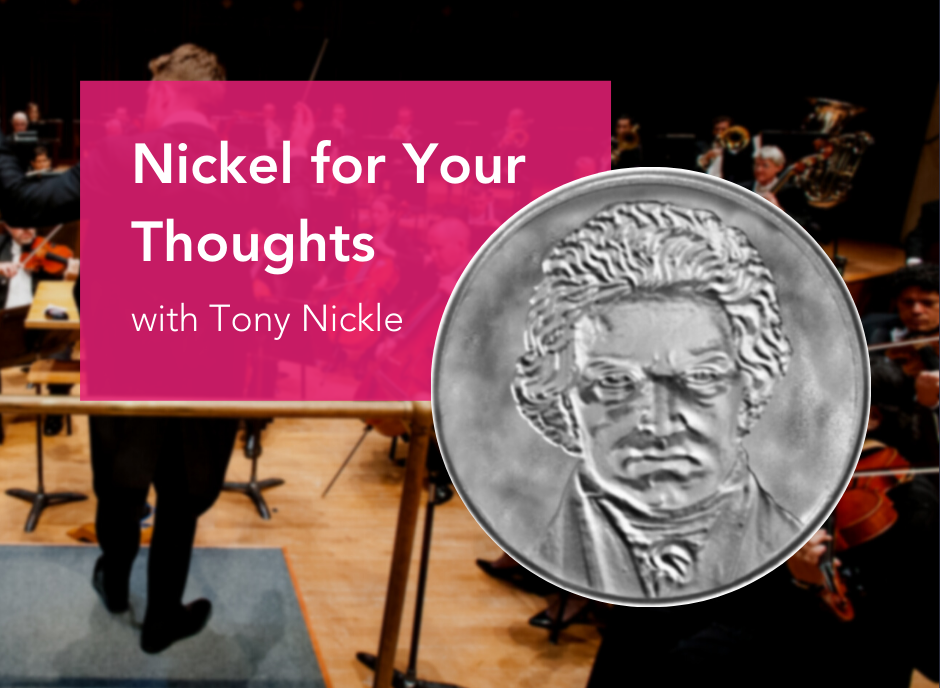In his own words, Artistic Administrator Tony Nickle shares what he believes to be the high points of the program, but with a little edge and humor for good measure.
As we welcome the music of English composer Benjamin Britten this week, we should count ourselves lucky that Northeast Florida has generously been providing us with suitably drab London-esque weather to set the stage. This week we pair his Serenade for Tenor, Horn and Strings with Robert Schumann’s bucolic Third Symphony. Both pieces are filled with scenic sound painting, combining to form a broad spectrum of beauty through two distinctly different compositional languages.
Britten’s Serenade was written somewhat near the end of World War II on the front end of an explosive few years of masterful vocal writing, also including his masterpiece operas Peter Grimes and Albert Herring (actually Herring is far from one of my favorites, but I’m feeling generous). The Serenade is considered a song cycle, a collection of songs often thematically connected in some way, but not part of a dramatic work like an opera. For this song cycle, Britten drew on existing works by six different English poets: Charles Cotton, Lord Alfred Tennyson, William Blake, an anonymous 15-century poet, Ben Jonson, and John Keats. The common thread throughout these texts is the theme of night. Many musical references to night tend to sound still, serene, or dreamy. Think Chopin’s Nocturnes or Debussy’s Nuages (Clouds). The Serenade certainly begins that way, with a Pastoral movement you could wrap up in and a Nocturne that sounds like fireflies dancing as you fall asleep with a shepherd’s horn in the distance (I’m sure we can all relate). But the next movement is an interesting turning point in the tone Britten paints. Quick bit of music theory, and I promise I’ll keep it brief: in Western, tonal music, major and minor harmonies are most simplistically created by a collection of three notes called a triad. The middle note of the triad is the money note that makes things sound major (bright, happy, sunny, lovey, etc.) or minor (dark, sad, scary, angry).
This next movement, Elegy, has a melody that pretends it’s going to be major on the first note, but then drops to creating a minor harmony on the second note. It’s been done before, but Britten uses it brilliantly with the text to pull the listener into a different realm of night; one less serene and more sinister. I’ll not go play by play through every movement, but it is a brilliant and heartfelt setting of the text to music, and our guest tenor, John Matthew Myers, sounds exquisite in the piece. Joining John at the front of the stage is our principal horn player, Kevin Reid. Britten wrote an equally important and exceedingly difficult solo for the French horn in the Serenade. At times he weaves its lines conversationally with those of the tenor, and at others it almost sounds like a wordless voice filled with subtext alongside the tenor and his poetry. It’s certainly a pairing with little precedent, and Britten achieved a staggering balance of timbre between the tenor voice and horn to create a captivating sound world. Orchestras don’t play this piece very often, and there is zero chance listening to a recording can capture the interplay of tenor and horn, so I strongly encourage you to join us in Jacoby Symphony Hall.
I won’t dive as deeply into Schumann’s Third Symphony except to say that it is a fantastic follow-up to our last Masterworks program featuring Beethoven’s Eroica and Strauss’ Metamorphosen; while those essentially represent the bookends of German Romanticism, Schumann’s Third (and last written) is, in so many ways, a noteworthy bridge traversing middle to late Romanticism. Programmatic representation of the Rhine River and the iconic cathedral in Cologne, an atypical five-movement structure, and a progressive (size, not social) brass section. Despite crippling his hands with a homemade machine designed to improve dexterity for playing the piano, and living with what would likely be diagnosed as bipolar disorder today, Schumann was an integral figure in the transition from Beethoven to Brahms, and this symphony certainly serves as a shepherd with swagger.
By Tony Nickle, Artistic Administrator


